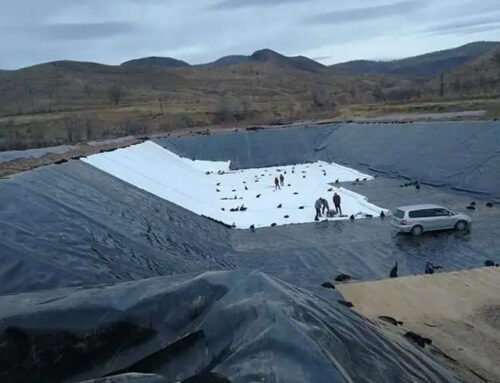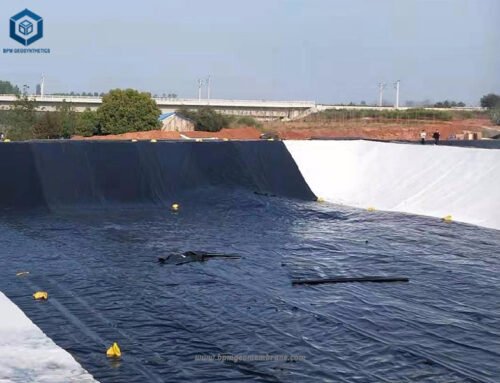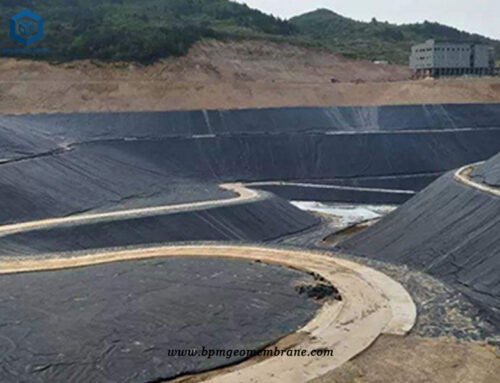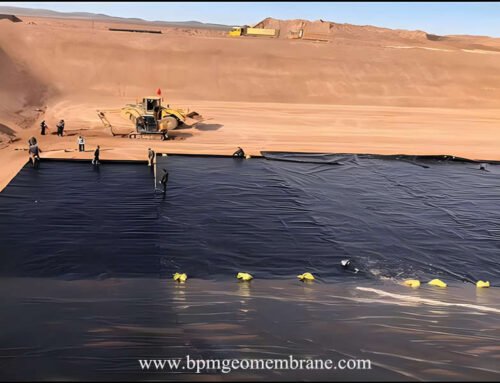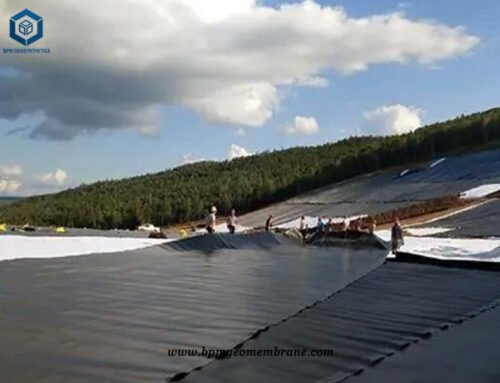HDPE pond liner installation is the procedures that the geomembrane pond liner how to install depending on the size and the edge landscape of the pond design. HDPE pond liner is also know as the HDPE geomembrane liner which contains approximately 98% high-density polyethylene, 2% carbon black and trace amounts of antioxidants and heat stabilizers, dimensional stability and thermal aging characteristics. It shows excellent environmental stress crack resistance, low temperature resistance, anti-aging, corrosion resistance, and a large operating temperature range to protect our water resource and environment.
1. How Do Evaporation Ponds Work?
Regardless of what they contain or the desired rate of evaporation, all ponds built for this purpose share some common features. They tend to be very shallow and have a large surface area rather than depth. This keeps fluids exposed to the surface to speed up evaporation through both wind and solar radiation. Water only evaporates from the surface where it meets the air, so large and shallow ponds work best for these applications. Deeper ponds, lakes, and tanks slow evaporation instead, making them more appropriate for long-term storage. Some evaporation ponds dry down until there is practically no liquid left, while others produce a concentrated sludge that requires further treatment or processing.
Evaporation ponds are essentially artificial ponds with very large surface areas that are designed to efficiently evaporation water by exposure to sunlight. The process and quality of HDPE pond liner installation is the key to control the leakage of waste liquid stored in evaporation pond. Evaporation ponds have several usages.
- Removing water from hazardous waste.
- Separating ore from water producing salt from seawater.
- Disposing of brine from desalination plants
2. Why is HDPE Pond Liner Essential?
Evaporation rates may be accelerated in these ponds, but they’re still highly controlled. Unlined ponds also lose water downward through seepage through the soil. This, speeds up the concentration process more than what’s intended, resulting in incomplete treatment or loss of valuable chemicals and minerals. Liners prevent seepage from affecting the speed of treatment, in addition to protecting the surrounding soil and water from environmental damage. With the right mining geomembrane liner, evaporation ponds can be used to process the harshest and most hazardous mixtures without concerns about the effects on the surrounding area.
3. Are Covers Needed?
Off-gassing is a major problem with certain types of mining evaporation ponds. Most ores don’t create many gases on their own, but the addition of solvents and other chemicals to induce metal separation can lead to the development of methane and hydrogen sulfide. If the ponds are located in areas near workers or residential areas, covers and active gas management systems are usually required for safety. Since these gases can be flammable, the covers used to contain them must be reliable and strong enough to withstand the rising and falling pressure levels without rupturing. Reinforced materials are much safer to use as gas covers during certain stages of evaporation or pre-processing.
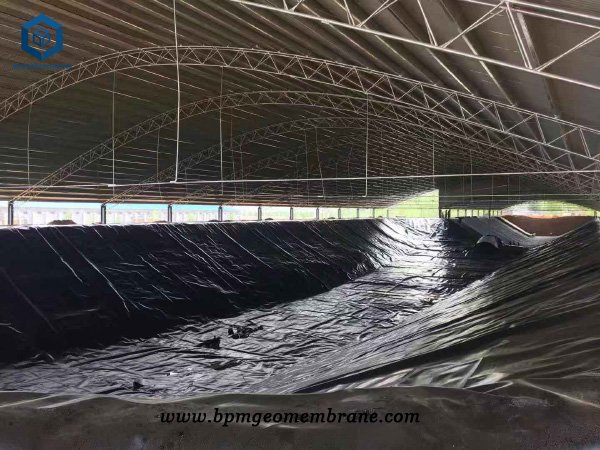
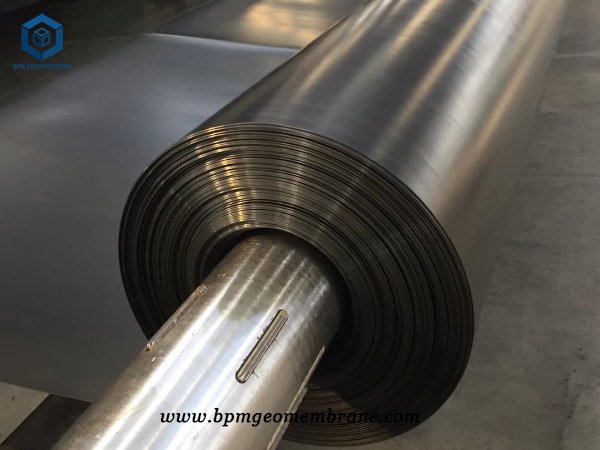
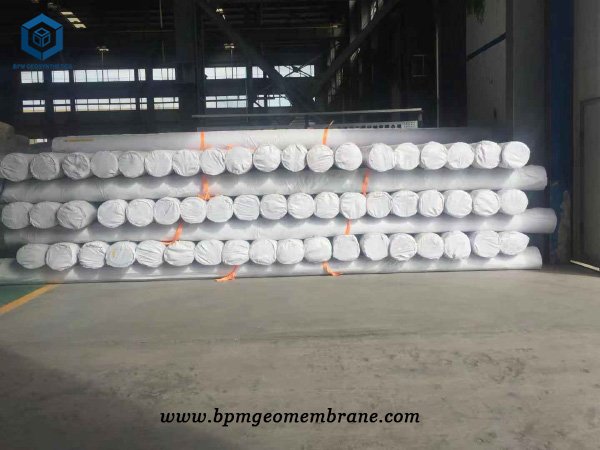
4. Why is Depth Essential in the Evaporation Pond?
Controlling the depth of the pond is the primary method for regulating the evaporation rate. Deeper ponds evaporate more slowly because of the reduced contact with the air. The deeper water also tends to stay cooler and resist the warming effects of the sun, further slowing evaporation rates. If a particular mining process requires a slow rate of water loss to allow time for settling or exposure to chemicals, plan for a deeper design that requires steep banks and therefore a more durable geomembrane liner.
5. How Does Surface Area Affect Evaporation Rates?
The second most important factor that goes into the evaporation rate of a particular mining pond is its total surface area. Increasing the surface area also increases the amount of contact the water makes with the air, which is the only point at which evaporation actually occurs. A very shallow pond will still have a slow rate of evaporation if it also has a small surface area. However, multiplying the surface area still has a smaller effect on the evaporation rate than depth alone for most mining mixtures. Make sure to adjust both measurements when aiming for a particular evaporation rate to achieve maximum ore or mineral extraction.
6. When Do HDPE Pond Liner Installation Need Underlayment?
Liners used in evaporation ponds may need an additional underlayment to protect the geomembrane from rips and tears. Leaks in evaporation ponds for mines tend to be more serious than those for other wastewater products because these ponds are used to process highly concentrated materials. There’s no dilution to mitigate the environmental effects of a leak. Underlayment protects the impermeable liner above them by acting as a cushion that softens the sharp edges of rocks and covers small voids. This reduces stress across the entire surface of the liner, preventing punctures and tears from developing over time. Rough and uneven soil will likely benefit from an underlayment cover before the geomembrane slides into place.
HDPE pond liner installation has been extensively used in some of the largest evaporation pond projects in the world. Here are several factors to consider when deciding which type of plastic pond liner to use in evaporation ponds.
- Low permeability
- Chemical resistance
- Temperature range
- Duration of the project
- UV exposure
BPM Morocco customer sent an inquiry the 1.0mm, 1.5mm, 2.0mm HDPE geomembrane pond liner prices and the HDPE pond liner installation services. We sent them HDPE pond lienr prices and loading quantity according to the details of these three thickness. By communication, we learned they needed the HDPE pond liner for evaporation pond. Then BPM recommended the 1.5mm HDPE geomembrane pond liner and sent them TRI test report, Intertek test report and ASTM technical parameters. They were satisfied with our professional service. Next day we sent the catalog by email, they contacted us to purchase the welder machine together with the geomembrane pond liner installation service. We gave them the competitive price of welder machine and details. The next three days, we talked about the prices and details, the customer placed the order.
7. Specifications of HDPE Pond Liner Installation for Evaporation pond in Morocco
- Total HDPE Pond Liner Quantity – 15,680 square meters
- Pod liner thickness – 1.5mm
- BPM900 Welder machine – 1 set
- One 40HQ container
8. About BPM Geomembrane
As the the professional geomembrane manufacturer and supplier, BPM Geomembrane has been dedicated to supplying one stop geomembranes and services to worldwide customers since its foundation in 2010. Our main innovative, high quality geosynthetics products include geomembranes, geotextiles, geocells, geosynthetic clay liners (GCLs), drainage boards, geogrids, etc. All BPM brand HDPE geomembranes have passed the certificates of the ISO9001, ISO14001, TUV, Soncap, SASO, BV certificates and the test of SGS and Intertek etc. Our geomembrane products have been exported to over 36 countries.

